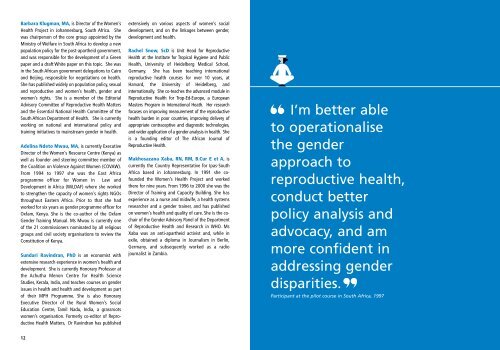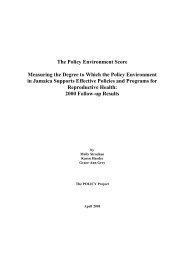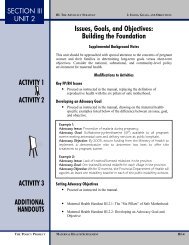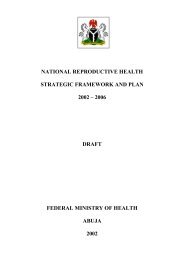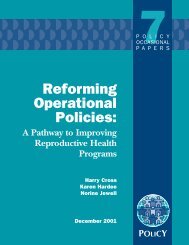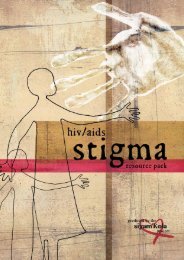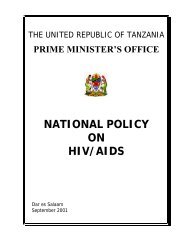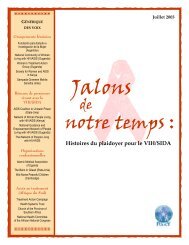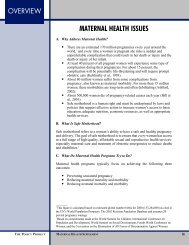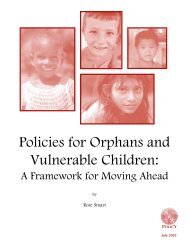Systems: Gender and Rights in Reproductive Health - POLICY Project
Systems: Gender and Rights in Reproductive Health - POLICY Project
Systems: Gender and Rights in Reproductive Health - POLICY Project
Create successful ePaper yourself
Turn your PDF publications into a flip-book with our unique Google optimized e-Paper software.
I was concerned before start<strong>in</strong>g that it may not<br />
have been appropriate because of the level of power<br />
that I have <strong>and</strong> that I may not be able to <strong>in</strong>fluence<br />
policies, but that soon disappeared! It was challeng<strong>in</strong>g,<br />
<strong>and</strong> it clarified <strong>and</strong> built on my knowledge base.<br />
Australia<br />
The Tra<strong>in</strong><strong>in</strong>g Manual<br />
Course Structure<br />
The course clarified<br />
my thoughts <strong>and</strong> feel<strong>in</strong>gs<br />
<strong>and</strong> empowered me to<br />
verbalise my feel<strong>in</strong>gs. I<br />
am gender sensitive<br />
but not completely<br />
woman-focused. Both<br />
sexes have different<br />
needs <strong>and</strong> whilst there<br />
is <strong>in</strong>equality, we must<br />
respect that both sexes<br />
have rights.<br />
South Africa<br />
Transform<strong>in</strong>g <strong>Health</strong> <strong>Systems</strong>: <strong>Gender</strong> <strong>and</strong> <strong>Rights</strong> <strong>in</strong> <strong>Reproductive</strong><br />
<strong>Health</strong>, is divided <strong>in</strong>to two ma<strong>in</strong> sections. The first section<br />
conta<strong>in</strong>s a brief chapter on the people who the course is for,<br />
what it consists of <strong>and</strong> how it is run. The second section<br />
presents the teach<strong>in</strong>g material for each of the six modules.<br />
Each module <strong>in</strong>cludes:<br />
• The module brief, giv<strong>in</strong>g the objectives, rational, <strong>and</strong><br />
essential read<strong>in</strong>gs for the module, <strong>and</strong> a table outl<strong>in</strong><strong>in</strong>g<br />
the sessions conta<strong>in</strong>ed <strong>in</strong> that module;<br />
•<br />
Session guidel<strong>in</strong>es for each of the sessions, expla<strong>in</strong><strong>in</strong>g<br />
the objectives, methodology <strong>and</strong> detailed guidel<strong>in</strong>es on<br />
runn<strong>in</strong>g the session;<br />
• Lecture notes <strong>and</strong> h<strong>and</strong>outs for the various sessions<br />
<strong>in</strong>cluded <strong>in</strong> that module.<br />
This section also conta<strong>in</strong>s a detailed description of the<br />
open<strong>in</strong>g session, <strong>and</strong> of the conclud<strong>in</strong>g session which is<br />
structured so that participants are able to make l<strong>in</strong>kages across<br />
all the modules <strong>and</strong> consolidate what they have learnt dur<strong>in</strong>g<br />
the course.<br />
Several annexes <strong>in</strong>clude additional material useful to<br />
tra<strong>in</strong>ers <strong>and</strong> facilitators of the course.<br />
• Information resources, <strong>and</strong> where to access the read<strong>in</strong>gs<br />
mentioned <strong>in</strong> the modules<br />
Model timetable<br />
Assessment tools<br />
Resource list on participatory methods<br />
•<br />
A compilation of “ice-breakers” <strong>and</strong> “energiser” exercises<br />
for groups.<br />
The tra<strong>in</strong><strong>in</strong>g manual is the outcome of a process of<br />
susta<strong>in</strong>ed <strong>in</strong>teraction between a number of actors <strong>in</strong> different<br />
parts of the world. This has ensured that the content of this<br />
manual has undergone several iterations, modifications <strong>and</strong><br />
ref<strong>in</strong>ements to produce an end product that offers a<br />
comprehensive <strong>and</strong> <strong>in</strong>novative look at gender <strong>and</strong> rights <strong>in</strong><br />
reproductive health.<br />
Determ<strong>in</strong>ants of <strong>Health</strong><br />
<strong>Gender</strong><br />
<strong>Gender</strong><br />
This module lays the basis for underst<strong>and</strong><strong>in</strong>g how the<br />
comb<strong>in</strong>ation of biological differences <strong>and</strong> gender <strong>in</strong>equalities<br />
has an impact on the health of women <strong>and</strong> men, on their<br />
health seek<strong>in</strong>g behaviour <strong>and</strong> their access to health services.<br />
On completion of this module participants will be able to<br />
• underst<strong>and</strong> how gender is constructed, ma<strong>in</strong>ta<strong>in</strong>ed <strong>and</strong><br />
re<strong>in</strong>forced, <strong>and</strong> the difference between sex <strong>and</strong> gender;<br />
• underst<strong>and</strong> how norms <strong>and</strong> values about gender roles are<br />
related to gender based <strong>in</strong>equalities <strong>in</strong> workloads, <strong>in</strong> access to<br />
education, control over economic resources <strong>and</strong> power;<br />
• have the skills to apply gender analysis to specific health<br />
conditions, to underst<strong>and</strong> how gender impacts on<br />
health status.<br />
Determ<strong>in</strong>ants of health<br />
This module exam<strong>in</strong>es the broad socio-political <strong>and</strong> economic<br />
context with<strong>in</strong> which health must be understood. It presents a<br />
framework for analys<strong>in</strong>g the social construction of health <strong>and</strong><br />
illness at household, community, national <strong>and</strong> <strong>in</strong>ternational levels.<br />
On completion of this module participants will be able to<br />
• apply a social determ<strong>in</strong>ants framework to the analysis of<br />
health;<br />
• identify the factors affect<strong>in</strong>g women’ health as they relate<br />
to their social <strong>and</strong> economic status <strong>and</strong> as they relate to men;<br />
• underst<strong>and</strong> the various levels at which health determ<strong>in</strong>ants<br />
operate, <strong>and</strong> how these levels <strong>in</strong>terrelate;<br />
• ga<strong>in</strong> an <strong>in</strong>sight <strong>in</strong>to how such analysis can shape <strong>and</strong><br />
<strong>in</strong>form policies <strong>and</strong> <strong>in</strong>terventions <strong>and</strong> to become aware of<br />
the structural factors underly<strong>in</strong>g the impact or success of<br />
policies <strong>and</strong> programmes.<br />
6<br />
7


